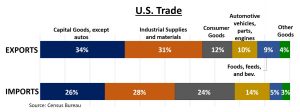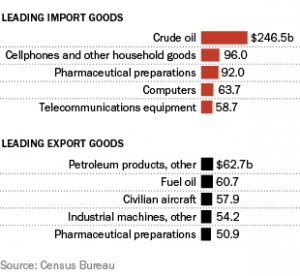Regardless of how big or small, all companies are impacted by global trade. Very few products are manufactured in their entirety in one country. Even baked goods can be impacted by the price of cocoa, sugar or the natural gas that lights their ovens. In a perfect world, free trade happens without any disruptions like tariffs, taxes, fees, incentives or laws which disrupt the unrestricted exchange of goods and services for an agreed upon value. Globally businesses and consumers across the world have become ever more dependent on each other.
In nature, an ecosystem has a way of balancing itself out and correcting opposite forces. In trade, government, regulation and human kind become forces charged with ideas of implementing change to preempt natural selection and thus add new complexities to international trade.
 We all know the only thing which is certain in the global supply chain, is uncertainty. As wealth shifts, and new markets open, the demand for goods and services shift. Consumers’ tastes and choices are also changing faster with new product developments and greater access to product data and information. Shopping and delivery models are shifting from manufacturer to retailer to direct consumer shipment and has rattled and sometimes closed entire businesses.
We all know the only thing which is certain in the global supply chain, is uncertainty. As wealth shifts, and new markets open, the demand for goods and services shift. Consumers’ tastes and choices are also changing faster with new product developments and greater access to product data and information. Shopping and delivery models are shifting from manufacturer to retailer to direct consumer shipment and has rattled and sometimes closed entire businesses.
 There are two thoughts when it comes to uncertainty: being prepared or dealing with the situation, if it occurs. The later can have devastating consequences. Recently, with the political leadership change in the U.S., many companies have been assessing the possible impacts on their supply chain. From raw material and components, to sales and markets of distribution.
There are two thoughts when it comes to uncertainty: being prepared or dealing with the situation, if it occurs. The later can have devastating consequences. Recently, with the political leadership change in the U.S., many companies have been assessing the possible impacts on their supply chain. From raw material and components, to sales and markets of distribution.
Whether natural disaster or unnatural regulation, businesses cannot change the hand they are dealt. However, they can be prepared. So what are companies doing in the wake of unprecedented pending changes in international trade?
Flexibility and predictive analytics is the key to survival. Most proactive companies are in the process of building models to analyze their costs, supplier base, supply chain and markets they distribute their products. Often companies have disaster recovery plans for their systems, but it is only those companies which survive, who test and modify their plan to changing conditions. This should be true of the supply chain and business modeling. We are seeing companies creating “what if” scenarios and developing contingency plans, should shifts in regulation and the economy alter the economic forecast and destabilize markets.
Another risk mitigating approach companies are taking is to diversify sources of supply and revenue. Being flexible is the key to survival. Companies which can shift their sources of supply or have alternative sources of production and delivery can weather a storm of taxing and tariffs. This doesn’t seem practical for small and capital intensive industries, because companies cannot easily shift production and build a new plant. It is easy to utter a phrase of, “bringing manufacturing jobs back”, but the realistic aspect of building a new plant is years in the making and not an easy decision when markets change in shorter time horizons. Even multi-billion dollar manufacturing companies cannot shift so easily when they operate a network of focused factories. Companies which can easily shift their supply and production are more successful in the long-term.
Lastly, always focus on the total costs of delivered goods and services. Successful companies consider all costs of labor, material, distribution, utilities, overhead, sales and administration in delivering their products and services. Often taxing and regulation focuses on the product because it is easy to track in terms of sales and distribution. Manufacturing companies need to consider the source of materials and components along with the conversion labor costs. Frequently companies moved their production closer to lower cost labor and raw material supply markets. However, with changes in taxing/trade policy the product will become more costly to import. Therefore, companies are looking for alternative in-country production while then outsourcing administrative labor in the form of shared services off-shore.
Preventing the potential gridlock of international trade requires:
- Understanding your total supply chain and operating costs
- Performing “what-if” planning scenarios
- Developing contingency plans and leveraging supply chain relationships
- Moving non-trade costs (Administration, Accounting, Order Entry, Engineering, etc.) to high quality lower labor cost markets.
Richard Sypniewski is SAGIN’s Managing Director & CEO who has worked with global companies to solve complex market and business problems. Richard has his MBA from the Kellogg School of Management, CPA and leader of the firm’s management consulting and advisory practice.
SAGIN is a professional services firm which works with companies to analyze, build and implement strategies which grow their business and manage risk. To learn more about SAGIN’s work in this area or others visit us at: www.saginllc.com or contact us at info@saginllc.com